Twenty years before the first national park, and more than a century before the Wilderness Act, (Henry David Thoreau) asked, "Why should not we ...have our national preserves, where ... the bear and pather ... may still exist, and not be 'civilized' off the face of the earth?" The Maine of his bark-canoe trips was the deepest wilderness Thoreau would see in his lifetime. Today, astonishingly, it looks much the same as it did when he saw it. Lake and river, many thousands of miles of shoreline are unbroken by human structures and are horizoned only by the tips of spruce.
John McPhee recounted Henry David Thoreau's experience, and added his own thought, more than three decades ago in The Survival of the Bark Canoe. It was, and remains, a great book about the craft of making bark canoes and, in turn, of exploring northern Maine's rivers and lakes by canoe.
No doubt more than a little has changed from that landscape that Thoreau enjoyed, and perhaps even since Mr. McPhee explored it on a 150-mile paddle with Henri Vaillancourt, who kept alive the art of building birch bark canoes. Enough remains, however, that many believe the rivers and lakes and the rumpled mountains and deep forests of Maine's North Woods deserve recognition as a national park.
"Just the fact that there's this large ecosystem that's intact, where there are no people living, there's no commercial development, and the native species still run the roost up there, that in itself is somewhat unusual for the Northeast, for the East Coast at all," says Roxanne Quimby. "And to preserve that ecosystem with its waterways, its moose and deer and beaver and brook trout and all the rest of the species that live there ... there's even Canada lynx up there."
So strongly does Ms. Quimby, who built a fortune making candles and personal care products under the Burt's Bees label, believe the landscape is worthy of "national park" status that she has offered to transfer roughly 70,000 acres of her land that butts up to Baxter State Park to the National Park Service.
The gesture, while seen as grand by many, is looked down upon by others who believe Maine's woods exist to be logged or that having the federal government in the backyard in the form of a national park would create too many "restrictions and rules."
"We have the American way and democracy and yet one person with deep pockets and tunnel vision is forcing her will on the masses," Mike Madore, a member of the Millinocket Town Council, told the Bangor Daily News back in August. "That is not democracy. That is dictatorship."
Ms. Quimby, though, isn't forcing the issue. Her 70,000 acres -- a large swath of watershed cut by the East Branch of the Penobscott River, a landscape dotted with timber, bogs, lakes, and ponds and streams -- won't be given over to the government without the support of Maine's politicians and residents, she says.
"Right now what we're trying to do is get some buy-in from the local folks for a feasibility study," she said during a long phone conversation last week. "And then if we can do that, then perhaps we can convince our (U.S.) senators to support a feasibility study. Right now they don't. So if we get local buy-in to put pressure on the senators to support a feasibility study, that's kind of the route we're taking."
Talk of creating a national park in Maine's North Woods has been kicking around for roughly 20 years. The drivers behind Restore: The North Woods long have envisioned a 3.2-million-acre park, one that would be 1 million acres larger than Yellowstone National Park and which would help wildlife species threatened with extinction for lack of habitat and protect the "wild forests of New England."
But that effort has struggled to gain traction.
"It seems quite impractical and unrealistic," says Ms. Quimby. "They don't have an execution plan. They have absolutely no plan on how that would come about. It's all privately owned right now. They're not fund-raising to buy it. I don't see that anybody's donating, so I just don't see how it can happen."
Economic Doldrums
Since the 1992 launch of Restore and today, the economy of northern Maine has been on somewhat of a downward spiral. The logging industry has retracted and retracted, no doubt partially due in part to massive stacks of timber coming out of British Columbia, where beetle-killed wood is being salvaged.
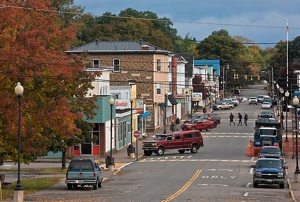
Can a national park spur Millinocket's economy? From QT Luong's collection of Maine photos, used with permission.
Its been long since timbering had its heyday in the small towns near the North Woods. Gone are the days when payrolls aproached 4,500, according to Ms. Quimby.
Three years ago the mill in Millinocket shuttered, and three months ago so did the one in East Millinocket, she points out. A national park, along with preserving a sublime landscape, would bring a significant boost to the economy, believes Ms. Quimby.
"One of the most important issues, I think, other than conservation of the ecosystem question, is the viability of the communities in the area," she says. "As the forest products industry declines, and the land becomes further fragmented through smaller land owners, I think that the ecosystem is in jeopardy.
"What has happened regionally to the communities is that they have suffered terribly with the decline of the only industry in the ara. In Millinocket, for example, one of the towns up there, there's an unemployment rate three times the Maine average. It's about 22 percent unemployment. They're having trouble filling the schools because there's not enough people to populate the schools," says Ms. Quimby.
"Businesses are closing. ... Basically there's very few opportunities for people to make a living. We have the oldest demographic in the country, the state of Maine does. More old people than any other state in the country. One of the reasons why is the young people leave. They have to leave to find a job."
The cachet of a "national park," she says, would help bring some of those jobs home. Bed-and-breakfasts could open to cater to tourists, guide services could be created, there could be coffee shops, restaurants, and Internet cafes, Ms. Quimby continues.
“I think that, superficially, if you are comparing say a chambermaid to a millworker, that the millworker does make more money by the hour. But tourism I think is valuable in that it can provide entrepreneurs with opportunities," she says. "And the entrepreneurs have the possibility of making a decent wage."
It also can bolster gateway towns, says Alex Brash, the Northeast regional director for the National Parks Conservation Association.
“Roxanne’s incredibly gracious offer to help create a new national park up there in time for the centennial would, even with just 70,000 acres, as the piece attached to in essence, contiguous with Baxter, clearly I think would jumpstart tourism up in that area," he says. "Just the branding by itself, it would bring more people who I think would particularly fly into Bangor, and then rent a car and do a two-, three-day trip, because it’s an hour-and-a-half one way to go down to Acadia (National Park) and Bar Harbor, and it’s an hour-and-a-half from Bangor to go back up to the North Woods.
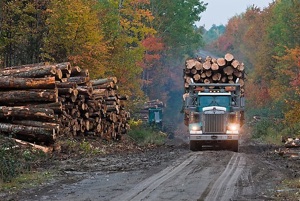
Logging has been on a long, slow decline in northern Maine. From QT Luong's collection of Maine photos, used with permission.
"Bangor would become a hub city more like Boulder (Colorado, near Rocky Mountain National Park) or something, and then you'd end up with something like two or three towns like Medway and Greenville and Millinocket that ultimately would become Estes Parks," the gateway to Rocky Mountain, says Mr. Brash.
Washington Is Listening
The appeal of a "North Woods" national park has reached all the way to Washington, D.C., where Interior Secretary Ken Salazar was so intrigued by the possibility that he and National Park Service Director Jon Jarvis traveled to Millinocket in mid-August to meet the locals and hear their thoughts on the proposal. The two didn't promote the idea, but rather tried to answer questions from those on both sides of the issue.
While only Congress can order a special resource study to assess the pros and cons of creating such a park in Maine, the Interior secretary could order the Park Service to do a smaller, less intensive, "reconnoissance study," says Michael Kellett, the executive director of Restore.
“I think he is thinking that that wouldn’t be a bad idea, if we can convince the members of Congress," Mr. Kellett says. "He knows (U.S. Sen.) Susan Collins from when he was in the Senate, apparently. ... But what he needs is to tell people to write to him and contact him and tell him to do a study, and write to their Congress folks."
If one of the concerns of those who oppose the idea is that a national park carries tight rules on what can, and can't, be done within its borders, perhaps what needs to be done is to take a look at life within the boundaries of Adirondacks State Park in New York. Far and away the largest state park in the country, at some 6.1 million acres, or roughly one-third the land mass of the Empire State, the park is a model example of blending multiple uses under the banner of a park.
"Within its boundaries are vast forests and rolling farmlands, towns and villages, mountains and valleys, lakes, ponds and free-flowing rivers, private lands and public forest," boasts the New York State Office of Parks, Recreation, and Historic Preservation.
That model -- a park that encompasses public and private lands and even villages -- is also seen in England.
Ms. Quimby's land in Maine sidles up to Baxter State Park, which covers more than 209,000 acres. Tying the two together could create a public lands preserve of nearly 300,000 acres of woods, streams, mountains, lakes and ponds. Stretch the boundaries further, as Restore would like to do, and a multiple-use landscape could be knit together.
Communities could remain in place, with the "park-and-preserve" boundaries excluding them, while sustainable logging, if economical, could be continued under Restore's vision. Too, tax roles could be maintained through federal "payments in lieu of taxes."
And 14 million acres of additional forestlands in Maine would remain outside the borders.
At the NPCA, Mr. Brash doesn't dismiss such an idea.
"I think going forward, if that does work, yeah, you would probably end up with something much more like an Adirondack kind of mixture of land ownership and land uses and so forth," says Mr. Brash. "The two things that we've consistently talked about and mentioned is that there are new models of national parks."
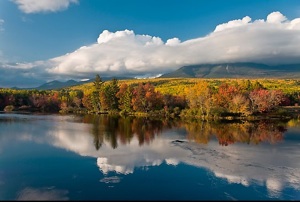
Ms. Quimby's land is adjacent to Baxter State Park (above). From QT Luong's collection of Maine photos, used with permission.
Of course, he points out, there are many units of the National Park System that allow various levels of use. Some permit snowmobiling and all-terrain vehicle or off-road vehicle use, and there also are units that allow hunting, said Mr. Brash.
In the end, if Maine was to land a new national park, the enabling legislation drawn up by Congress would specify what uses would be permissable, he added.
How the Maine idea evolves could influence future decisions on how national parks might function, says Ron Tipton, NPCA's senior vice president for policy.
"I think this type of park model will become more prevalent, given there are fewer and fewer pristine landscapes but also continuing interest in creating new parks. It's also clear to me that future national parks will more often follow the Santa Monica (Mountains NRA) model of multiple partners and more limited NPS ownership," he says.
"As for Maine, I expect we will ultimately have a core national park that is managed similar to a traditional park unit surrounded by some combination of park preserve, heritage area and/or an Adirondack Park-like overlay. It makes total sense; in fact, the Adirondacks are a great model for the Maine Woods," Mr. Tipton added.
Pieces Of The Puzzle And Perseverance
A national park, whether just comprised of Ms. Quimby's 70,000 or so acres, or paired with Baxter State Park, or perhaps even moving towards the scale of Restore's 3.2-million-acre vision, would be key to a point or two Park Service Director Jarvis made early in late August when he outlined to the agency's employees a Call To Action to prepare the Park Service for its second century, which begins in 2016, the year that Ms. Quimby would like to see her gift formalized as a new park.
One aspect of that blueprint calls for creating "a national system of parks and protected sites (rivers, heritage areas, trails, and landmarks) that fully represents our natural resources and the nation's cultural experience." Another calls for promoting creation of "continuous corridors" to support ecosystems.
A national park in the North Woods of Maine certainly would help accomplish both those goals.
"Either parks are becoming increasingly isolated, or we have to figure out a way to maintain corridors and connectivity and have a gradation of landscapes around them so that ultimately the grizzlies from Glacier can still find the grizzlies in Yellowstone every once in a while, and, you know, the birds migrating along the Atlantic Coast, from the barrier islands, Cape Cod to Cape Canaveral, will have feeding and roosting sites all along the way that will still have berry trees and so forth," says the NPCA's Mr. Brash.
"Any number of examples everywhere. So, I think clearly if we’re going to maintain the ecological integrity to a reasonable extent in our country, we’re going to have to figure out how to have these kinds of mixed landscapes.”
Down through the history of the National Park System there have been more than a few private citizens who have come forward to help build the system. John D. Rockefeller, Jr., played a key role and spent tens of millions of dollars in either creating or adding to Grand Teton National Park, Acadia, Great Smoky Mountains, Yosemite National Park, and Shenandoah National Park.
His son, Laurance, was significant in the creation of Virgin Islands National Park and in the creation of the National Park Foundation, the charitable arm for the Park Service.
George Dorr spent four decades of his life and much of his own fortune to see Acadia gain national park status.
Study Maine's history and you'll learn about Percival Baxter's donation that led to the state park named after him.
These individuals and their determination and perseverance give no small measure of resolve to Ms. Quimby.
"That's very inspiring to see what people have been done in the past, and a great inspiration to me," she says. "And I’ve read a lot about them, because in my moments of doubt I need to hear that other people who have tried to create parks also had a lot of pushback, and a lot of challenges, a lot of local resistance. I find it inspiring to know that they overcame that resistance.”

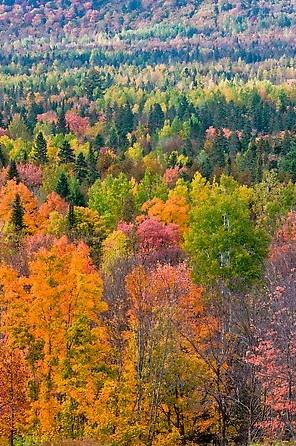
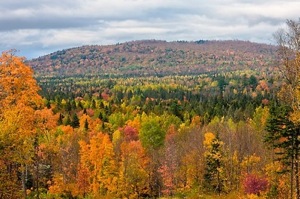


Comments
That's right. The entry of land developers into the Maine backcountry is really the other side of the story. Although there has been a substantial downturn in the real estate market recently, what most of them propose is development, too, but in the mold of extensive---rural residential---conversions, first on lakes---like you see in western New Jersey and the Poconos, then like Deltona, Palm Coast, and North Port, Florida. Undoubtedly, most of these homes would be second homes or vacation homes. If folks think a park creates wholesale transformation of ways-of-life, access to land, and environmental changes, residential development does all that AND A WHOLE LOT MORE. I grew up in Florida and have seen it firsthand. Unfortunately, once the scenic beauty of the Maine Woods was identified by Plum Creek, et al., it didn't take long for them to apply the same economics to Moosehead Lake that has been applied to Lake Tahoe, Lake Wallenpaupack, Lake of the Woods, etc. It will be promoted in urban areas (NYC, Boston, Hartford, Philadelphia, etc.) as that "unspoiled" wilderness you've always sought, and more PFAs will arrive than you can imagine.
In stark terms, do you want a park/forest/recreation area or a resort community? You will get one---or the other? And you might get both!
I sense a some inherent paradoxes in "Anon's" statements. If Ms. Quimby purchased the land, she has all the private property rights she needs to block access, cancel camp leases, deny access, etc. Bravo for those rights. Non-owners don't have the right to access her lands without paying for the privilege or getting specific permission. She also has the property right to convey, sell, transfer, etc. the land to any party she wants---without restriction. If she has imposed the level of restriction stated on the land, having the land in NPS or USFS management will actual open access. It might not be unrestricted access by any means (e.g. snowmobile, airplane, ORV, etc.) but I defy anyone to find a park that has "Keep Out" signs posted for anything but prevention-of-resource-damage reasons. They aren't generally fenced, and they certainly aren't tightly patrolled. You might have to canoe, horseback, or walk to get there, but you won't find the keep out signs.
"What law is Quimby breaking by donating her land to the United States?"
The National Park Service cannot establish a new area without Congressional authorization. Quimby does not have a "right" to do that on her own and the National Park Service has no right to accept it. Government does not act by "right"; individuals do. That is why we have a constitutional form of government limiting government action.
Morally, no one has a "right" to change the form of goverment into one more dictatorial. That kind of power is not hers to give to the National Park Service.
"I think the issue under lying all of the opposition to this park is that rural Mainers hate and fear PFAs--People From Away. If you aren't a 4th generation Mainiac, then your thoughts, values, and opinions have no value to the self described "True Mainer". These people know that a park will bring in lots of PFAs,..."
This is a smear that is non-responsive to the objections to National Park Service control.
As a factual matter there are many people from many different places who own property or live in Maine. People enjoy what they have and don't want it taken away by outside political forces like the National Park Service and its pressure groups. It is terribly arrogant to decide that you like an area so much that you think you can take it over for your own purposes and then blame the victims for being an ignorant subclass of humanity in comparison with your allegedly superior judgment on behalf of some allegedly "higher" standard.
"Anon wrote, 'Where the government controls the land there are no private property rights.' Obviously. But if someone donates their land for public enjoyment, that person's 'rights' aren't being taken away by the U.S. government. It's equally obvious that the creation of a national park does not imply any 'agenda' to 'remove private property rights' or to 'abolish private property rights.' This is nonsense. I imagine the millions of Americans who visit the parks every year are pretty comfortable with private property."
The National Park Service takes property from people. Quimby's "seed" is intended to establish Federal control over millions of acres of other people's private property.
Once the National Park Service has the land, regardless of how it gets it, there is no more private property in the entire region. The political and economic system based on protection of private property rights is gone forever. It is replaced by a system of complete government control over all the land. That is the elimination of private property rights.
That has been the agenda of NPCA, Restore and Quimby for decades. It is not new. They want to eliminate industry and eliminate private property rights in principle over millions of acres of private property in Maine. They have said so. Quimby has been quoted directly saying she is opposed to private property and that she wants to use a National Park to eliminate it previously on this page. That most visitors to National Parks don't realize that or the fact that the National Park Service uses eminent domain to seize property does not mean that isn't the agenda of the pressure groups and a real threat to property owners now in the future. There have already been more than enough problems with this at Acadia and the Appalachian Trail in Maine.
"Anon wrote, 'In contrast, Quimby is buying up as much as land as she can in order to impose wilderness 'ecosystem restoration' and prevent human use forever.' She's donating it to be a national park and preserve! How could that mean "prevent[ing] human use forever"? It means the exact opposite! A park that would forever keep open the land for camping, backpacking, hiking, fishing, etc. and a preserve for hunting, snowmobiling, etc."
Quimby and Restore want government imposed wilderness or the equivalent specifically for "ecosytem restoration". Allowing a handful of hikers with the ability, resources and inclination to spend days or weeks walking into areas no one else can get to is not human use of the land by any ordinary meaning of the term. It is a ban on human civilization.
Whether or not Quimby were to get restrictions to that full degree in the beginning the pressure groups are constantly lobbying to further restrict access and recreation -- they hate anything with a gasoline engine, hate inholdings and always want "buffer zones" and expansion -- resulting in a constant uphill battle against well-funded lobbyists and Washington insiders that no one should bave to be subjected to.
The National Park Service and its lobby have a record. People are finding out and the chickens have come home to roost. Normal people in Maine do want to be pushed into living under that and the increasing Federal control and arbitrary bureaucrat crack downs that comes with it. Political and economic freedom matter to people personally. People in rural Maine like the way of life they already have and don't want more restrictions and unending political threats to make it even worse just because the park lobby wants what we have.
"I've done some checking on what the issues are, and it does get complex. One concern in Maine seems to be that many of the traditional timber concerns are selling out to housing developers. These timber companies were willing to allow recreational users on their property for hunting, snowmobiling, etc if they sought permission. It's the developers who might not understand the local culture, and when they start developing housing the land may be permanently kept from public recreational users."
That "concern" is a myth that has been promulgated by the park lobby as part of its PR campaign for decades. The "complexity" is not what you have been led to believe. There are not many homes across 10 million acres, and where there are homes in more settled townships there is nothing wrong with that. Far more land has been put under consevation easements than has been sold for homes.
The bigger problem in this realm is that there are already too many state restrictions killing the economy and property rights. People's homes are hated only by the park lobby because it wants the land. That is why they constantly demonize "second homes" trying to fan envy and resentment, etc.
The Plum Creek plan in particular is extremely low density, intended to evolve in accordance with a well-thought out plan over 30 years or more, and includes 400,000 acres of permanent conservation land not subject to development.
"A ban on human civilization?" Really? "hate anything with a gasoline engine?" Hate? Anything with a gasoline engine? This language is so hyperbolic and over-the-top, it doesn't bear even a nodding acquaintance with reality.